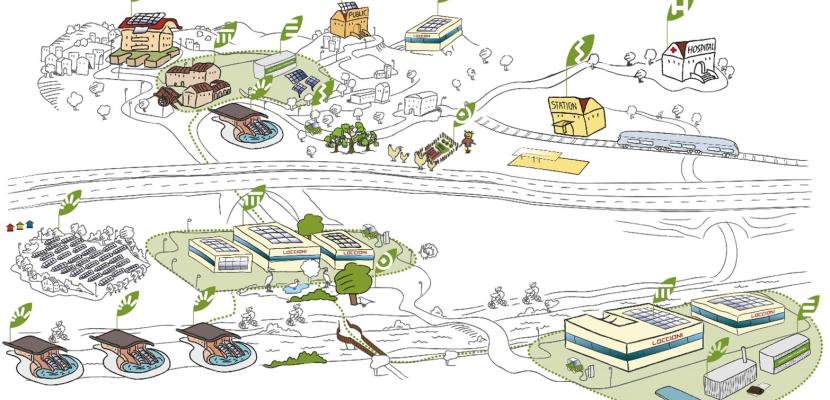
The Leaf Community Loccioni - a micro grid, full electric powered by renewable energy sources

About this good practice
The Loccioni microgrid is a functional example of a peer-to-peer power network, distributing energy between Loccioni buildings within a 2 km of future. Over 90% of the energy produced is self-consumed, increasing self-sufficiency to 55%.
This local system emphasizes the advantages of diversifying and integrating renewable energy sources to enhance reliability and reduce CO2 emissions, improving the community's environmental sustainability.
The Leaf Lab, a Class A+ building, serves as the core of the microgrid, designed for optimal comfort, cost-efficiency, and energy management. It generates, stores, and distributes renewable energy based on demand, while smartly managing energy flows and sharing surplus energy with other buildings in the Leaf Community.
The energy mix includes:
• Sun: 2 MW of PV systems installed on the roofs of the microgrid, and in the country side 920 kW PV system was repowered, increasing production by 800 kW.
• Water: Four micro hydropower plants generate 550 MWh annually and contribute to thermal energy production via heat pumps.
• Biomass: An innovative pellet biomass cogeneration system produces electricity and thermal energy 24/7, storing heat in a 450m³ water tank.
A 1.8 MWh second life storage system, developed in collaboration with ENEL, Nissan, and Samsung, enhances the community's energy autonomy, integrating electric vehicles and smart grid technologies.
Expert opinion
Resources needed
Loccioni's investment of over 3 million euros in public land has not only prevented several floods but also created new skills, jobs, and value in the region. The return on renewable energy plant investments averages 8 years, with profits reinvested in energy, environmental, and local projects.
Evidence of success
In 2023, the Loccioni Leaf Community despite the increase in laboratories, people and work, decreased in grid withdrawals, and reached a production of more than 4675 MWh of renewable energy.
For 10% of the working hours the withdrawal from the grid is 0, with the whole campus virtually in an energy island while 25% of the hours the consumption is 0 to 15 kW of withdrawal!
It produces more energy than it consumes avoiding more than 1192 tons of CO2 emissions, a negative 225 t of CO2emitter.
Potential for learning or transfer
The project has secured an entire area from a hydrogeological point of view. It is an open and public river park, provided with information points, where schools and community people can walk and learn about the river story, the improvement in sustainability and safety and how the river can be an energy resource. This was acknowledged by The European Solar Prize, won by Loccioni in 2023.Widespread collaboration, recovery and renewable energy activities, along with the smart grid is a valid feasible path to build a sustainable future, in terms of environmental and work opportunities. The project concurs significantly to the energy balance of Loccioni microgrid, since 2022 has become a profitable project also from an economic point of view.
An entirely private investment in collaboration with the public which created a laboratory for joint innovation and design; an investment in the future to secure and enhance the river area, and to rediscover the river as an energy and culture resource
Further information
Good practice owner
You can contact the good practice owner below for more detailed information.
